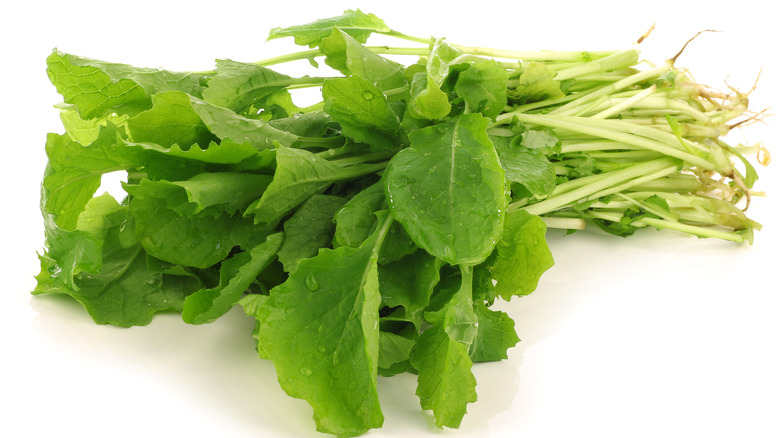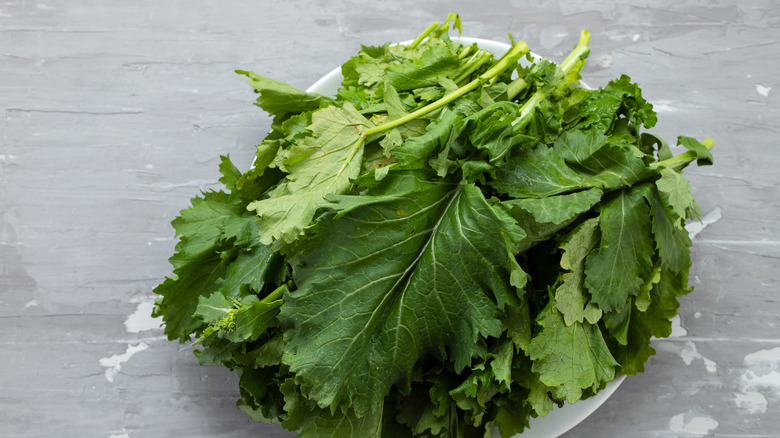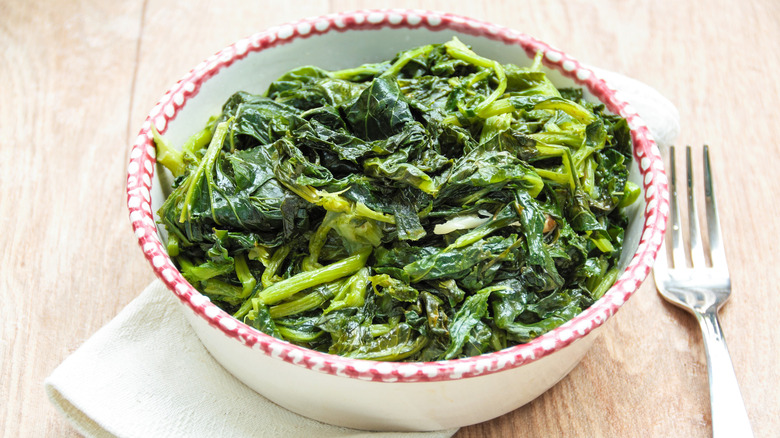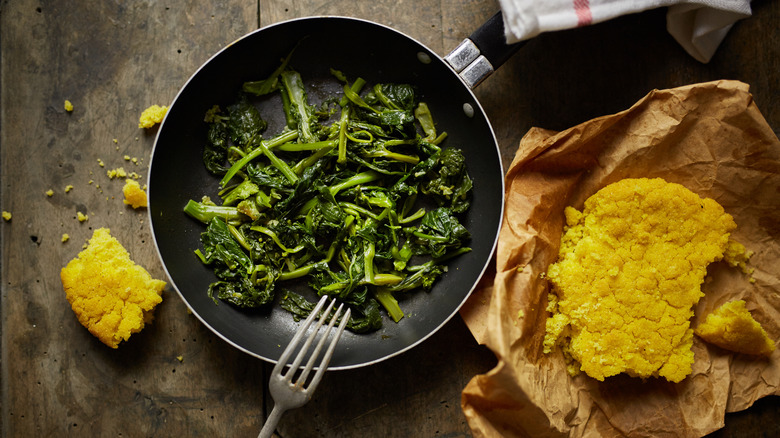What Are Turnip Greens And What Do They Taste Like?
The kale craze of the 2010s appears to be waning (via The Atlantic), making way for other leafy superfoods (like, say, turnip greens) to have their moment in the sun. But while the leaves the venerable turnip plant (a member of the cruciferous Brassicaceae family, according to Wholistic Matters) rival kale's nutritional value — it's actually a slightly better source of fiber, iron, calcium, and potassium (via My Food Data) — Wholistic Matters says turnip greens just haven't drummed up the same excitement kale garnered among its smoothie-drinking, salad-eating, greens-loving fan base.
Wholistic Matters says turnips were probably first domesticated in Ancient Greece, where they gained favor because they could last through winter. Probably for the same reason, they were a popular crop in Nordic countries, at least until the 18th century, when potatoes nudged them aside.
Turnip greens, the part of the plant that grows above ground, can be served cooked or raw, but they are fibrous, so most people prefer them sautéed or braised. Like kale, they're also an easy and nutritional addition to soups and stews.
What do turnip greens taste like?
According to Foods Guy, the taste of turnip greens can range from mild and slightly sweet to peppery and just a little bit bitter. It all depends on when they are harvested. The younger the plant, the more mild the flavor. More mature plants develop a pleasantly peppery taste reminiscent of extra-mild arugula. Depending on your preference, consider using younger greens in uncooked preparations, like salads. Save the mature leaves for recipes that call for cooked greens.
If you're still not sure what to expect in terms of taste from the greens, Cooking Chew also explains that turnip greens, while peppery, don't pack as much heat as mustard greens and that they are sweeter than collard greens. Cooking Chew also notes that, whether raw or cooked, removal of the stems makes the greens easier to eat. Cooking the leaves down, like in Country Turnip Greens, will help to eliminate any bitterness.
How to cook turnip greens
Turnip greens are pretty versatile, according to Harvest to Table. If you're going with a raw preparation, choose greens that are harvested before the root (the actual turnip) begins to form. That's when they are at their mildest.
When it comes to cooking, almost any manner of preparation works — steaming, sautéed, and boiling are common, and easy, choices. To prepare for cooking, rinse the greens in a bowl of lukewarm (not cold) water and swish them around to dislodge any sand or dirt from the garden. To remove the stems, one by one fold each leaf in half vertically to loosen and pull the stem away from the middle.
For a simple side dish, heat olive oil in a pan, toss in a bit of chopped garlic, add the turnip green, and cook. Ready to try something a bit more challenging? Divas Can Cook suggests creating a soul food-inspired dish. In a saucepan over medium heat, combine chicken broth, chopped onions, chopped garlic, chopped red bell pepper, smoked turkey, red pepper flakes, and liquid smoke. Add a touch of hot sauce and turnip greens. Cook until the turnip greens wilt.
Are turnip greens good for you?
Why, yes. Yes, they are. According to Medical News Today, turnip greens are high in nutrients, but low in calories. In fact, turnip greens rank at the top (1,000 on a scale of one to 1,000) point of the Aggregate Nutrient Density Index, a scoring system created to rank foods based on nutrients per calorie (via Simply Fresh). That's the kind of nutrition bang for calorie buck we like to know about. Among the many health benefits, says Medical News Today, turnip greens are rich in calcium, iron, magnesium, phosphorus, and potassium, in addition to noteworthy amounts of vitamin C, folate, vitamin A, and vitamin K.
What does all this mean in terms of the actual physical benefits of consuming turnip greens? Without going into way too much detail, we can confirm turnip greens help promote cardiovascular health, healthy skin and hair, and bone health. Eating turnip greens also helps stabilize blood sugar levels, and they contain antioxidants that aid the body in fighting free radicals that can lead to complications like cancer.



